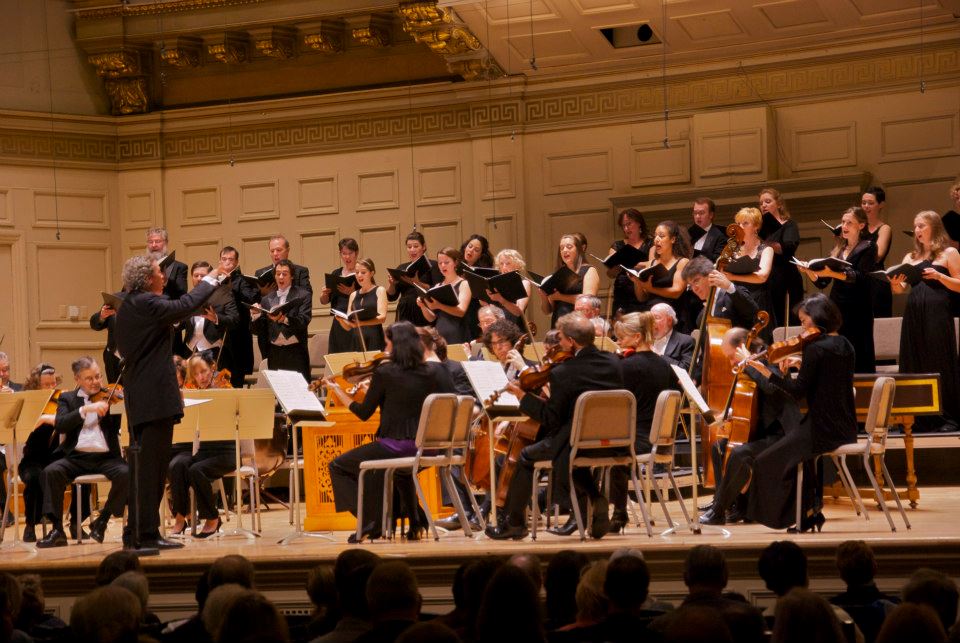Concert Review: Bach’s Magnificat etc. with the Handel and Haydn Society/Harry Christophers
Friday’s was the first of a series of strong, interesting programs H&H is offering this season. If its success is any indication of what’s to come (and I hope it is), we should have a very special few months ahead of us, indeed.
By Jonathan Blumhofer.
“I think we’ve aged rather well, haven’t we?” Handel and Haydn Society (H&H) artistic director Harry Christophers joked in his brief remarks that prefaced the first concert of the Society’s 198th season on Friday evening. Indeed, they have: it’s hard to imagine a group that regularly conveys more palpable enthusiasm for the repertoire they play than H&H, as this weekend’s involved and exciting performance demonstrated.
Friday’s all-Bach program (repeated on Sunday afternoon) alternated pieces that showcased the Society’s period instrument orchestra and chorus, beginning with the well-known Orchestral Suite no. 3 in D major. Christophers drew lithe, energetic performances of the brisk dance movements that close the Suite and a majestic, stately account of the extended Overture that begins it. In between came a beautifully phrased, moving (both in terms of tempo and expressive quality) reading of the famous “Air” that emphasized the melodic line and textural clarity above any sentimental excesses performers sometimes find in the piece.
Bach wrote the cantata Gott ist mein König very early in his career (1708, to be exact), and it brims with youthful energy. Cast in seven movements, it is not a church cantata; rather, it was composed to celebrate the election of the Mühlhausen town council that year and, at the time, proved to be one of Bach’s most popular works.
Above all else, Friday’s performance of the it demonstrated just what a fine instrument the 30-voice H&H Chorus is. Gott ist mein König isn’t a piece that runs the gamut of technical and stylistic devices like the B Minor Mass (or the Magnificat), though it does feature extended imitative sections alongside more homorhythmic textures. Throughout, the H&H Chorus sang with full-bodied phrasing, textural clarity, and sensitivity to German diction that was remarkable.
The score’s six soloists were drawn from the chorus, and all of them competently held their own. Teresa Wakim’s rendition of the soprano part was the highlight, marked by lustrous phrasing and golden tone. Similarly, tenor Marcio de Oliveira brought nice character to his solo, the account of the 80-year-old Joseph; and bass Donald Wilkinson’s sonorous recitation of his arioso, “Tag und Nacht,” added a satisfying gravitas to the cantata’s midpoint.
Alto Emily Marvosh was kind of the odd-soloist-out in this piece: in the solo quartets that opened and closed the cantata, she was generally buried by the other singers, and in her own solo (“Durch mächtige Kraft”), she started a bit stridently before mellowing somewhat.
After intermission came a curious hodgepodge of short selections, including two cantata sinfonias never before performed by H&H, to set up the second half’s main event, the Magnificat.
Both sinfonias were nicely played, even if their placement on the program seemed a bit arbitrary on paper. The first, from the cantata Gleichwie der Regen und Schnee vom Himmel fällt (BWV 18), featured some wonderfully dusky interplay between four solo violas and two flauto dolce. The second, drawn from the cantata Die Elenden sollen essen (BWV 75), pleasingly exhibited Paul Perfetti’s slide trumpet solos on the chorale tune, “Was Gott tut, das ist wohlgetan,” as well as some vigorous, imitative string figurations between his entrances. Betwixt the sinfonias came a reading of “Jesus bleibet meine Freude,” from the cantata Herz und Mund und Tat und Leben (BWV 147), that stressed the development of the chorale tune’s melodic line over Bach’s bubbling accompaniment.
To close the evening, Christophers and Co. turned to Bach’s great Magnificat of 1723. In many ways, the Magnificat shows Bach at his best: 12 concise movements that, between them, convey a world of character, color, and emotion that many more ambitious scores struggle to match. Friday’s performance left little to be desired, either by way of interpretation or by impact of performance.
Again, the H&H Chorus was at the center of the action, gamely declaiming Bach’s intricate contrapuntal lines and filling their extended sections with great, musical drama. Among the highlights, the fugal “Omnes generationes” stood out for sheer power, while the “Suscepit Israel” allowed the chorus to demonstrate a haunting, focused introspection.

The opening weekend performance of the Handel and Haydn Society — the orchestra, though they weren’t the sole attraction onstage all night, performed very strongly throughout.
Soloists in the Magnificat were again drawn from the chorus and included four who sang in the earlier cantata. As before, a clear, honeyed tone, beautiful phrasing, and a strong sense of the melodic line marked Ms. Wakim’s account of the aria “Quia respexit humilitatem.” Tenor Stefan Reed and bass Jacob Cooper provided noble interpretations of their respective solos, as did soprano Erika Vogel of hers (though her voice was often covered by the orchestra in its low range). It was Ms. Marvosh, though, who stole the show, so to speak, among the soloists in this Magnificat, with a delightfully ingratiating reading of the aria “Esurientes implevit” that captured all of the music’s latent charm and then some: she was handsomely aided by Christophers’s sensitive accompaniment and the lilting wind playing of the H&H Orchestra.
And the orchestra, though they weren’t the sole attraction onstage all night, performed very strongly throughout. Special praise is due trumpeters Bruce Hall, Jesse Levine, and the aforementioned Mr. Perfetti, for their majestic accounts of Bach’s often-demanding brass writing. Similarly, the basso continuo built around harpsichordist/organist Ian Watson provided an underpinning of strength and sensitivity upon which the rest of the ensemble could—and did—securely build.
Friday’s was the first of a series of strong, interesting programs H&H is offering this season. If its success is any indication of what’s to come (and I hope it is), we should have a very special few months ahead of us, indeed.

